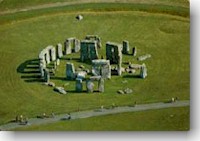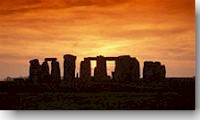Not since the CBS special " Stonehenge" in the early 60, have I been so fascinated by a TV docu-drama " Longitude" on A&E, a four-hour long program. It made an old dog wonder,
and that is no small task.

In " Stonehenge", hosted by Harry Reasoner, the fascinating element was about how the astronomers lined up the all known stars in the sky with Stonehenge using computers, and
discovered that Stonehenge was an observatory. Computer calculations suggested that the first ray of Sunlight on the first day of summer
( June 21 in Northern Hemisphere) could be observed by standing in the center of Stonehenge and look through a given small gap between two stone pillars topped with a cross stone bar.
The test was to set up a camera in the center of Stonehenge the night before June 21 and wait for sunrise. Reasoner and the camera crew camped there and took the entire generation of curious viewers with them. Daybreak came, the Sun started to rise, tension mounted, and finally the first ray of sun suddenly pierced through the small gap between the two stone pillars and blinded the TV camera. The entire generation of viewers roared with excitement along with Reasoner and the camera crew.

What a triumph for science.
It was found later that the Sun Ray was slightly off due to precession of the Earth along its axis over the years. When the age of Stonehenge was taken consideration, and the
precession effect was corrected for, the ray of Sunlight on June 21 in ancient time would be right on. How did these guys know this sort thing in those days to construct something like that? Isn't this a most fascinating thing?
In the case of "Longitude", it is even more fascinating, because it has a story, in fact two stories, associated with this most puzzling problem in navigation since time began.
In the 1600 and early 1700, no one knew how to determine the meridian of longitude at sea. Many many ships went the wrong way, let alone ships lost at sea and never to return. This could be the reason that Columbus set sail for China and ended up in South America. This problem had caused the British Navy great concern.
In 1714 a "Board of Longitude " was appointed in England to study the problem by the Royal Society. The Board decided to set up a prize to award anyone who could figure out the longitude to within half a degree at sea (slightly less than 35 miles along the Equator and zero mile at the pole) after a six-week sea voyage from England to the West Indies. The award was ?20,000, a huge sum in those days.
Many tried and failed including Newton, Hooke (the rubber band) , Halley (the Comet) and other very accomplished scientists. It was proclaimed to be unsolvable, until Harrison, a carpenter/mechanic, came along...

Next  |


![]()
![]() Get
your own Free Home Page
Get
your own Free Home Page